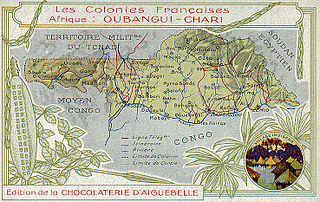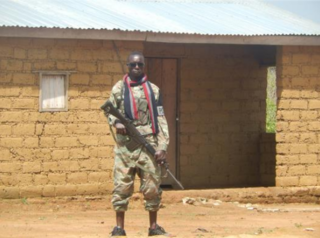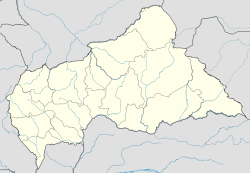
The history of the Central African Republic is roughly composed of four distinct periods. The earliest period of settlement began around 10,000 years ago when nomadic people first began to settle, farm and fish in the region. The next period began around 10,000 years prior.

Bria is the capital of Haute-Kotto, one of the 14 prefectures of the Central African Republic. As of the 2003 census the town had a population of 35,204.

Kabo is a town in the northern Central African Republic, lying north west of Kaga Bandoro. It is a market town and the border post for Chad.
Ouadda is a town located in the Central African Republic prefecture of Haute-Kotto.
Ippy is a town located in the Central African Republic prefecture of Ouaka, near the geographic center of the country. It is 364 kilometers from the city of Bangui directly. Driving distance, however, is 496 kilometers.

The Central African Republic Bush War was a civil war in the Central African Republic which lasted from 2004 to 2007 between Union of Democratic Forces for Unity (UFDR) rebels and government forces. The rebellion began after François Bozizé seized the nation's presidency in 2003. Actual fighting began in 2004. Around 10,000 people were displaced because of the civil unrest.
Ouanda Djallé is a sub-prefecture and town in the prefecture of Vakaga in the Central African Republic. It is located 130 km south of Birao. By population it is one of the smallest sub-prefectures in the country.
Gordil is a town in the Vakaga Prefecture of the northern Central African Republic.

Markounda, formerly Fort-Brusseaux, is a sub-prefecture and town in the Ouham Prefecture of the north-western Central African Republic. The sub-prefecture borders with Chad.
Am Dafok, also spelt Am Dafock, is a Sub-Prefecture and town in the Vakaga prefecture of Central African Republic (CAR). The town sits on the CAR side of the border with Sudan; on the Sudanese side of the border lies Um Dafuq in the state of South Darfur.
Movement of Central African Liberators for Justice was a rebel group in the Central African Republic led by Abakor Sabone. The group had splintered from the Union of Democratic Forces for Unity and was involved in fighting in the Central African Republic Bush War. The group mainly drew from the Kara ethnic group.

The Democratic Front of the Central African People was an anti-government militia in the Central African Republic (CAR). It was one of the major combatants in the CAR Bush War and a member of the Séléka CPSK-CPJP-UFDR alliance of militant groups that overthrew the national government in March 2013.
Bambouti is a sub-prefecture of Haut-Mbomou in the Central African Republic. The town is abandoned by the country.

In 2020 heavy clashes between ex-Séléka groups erupted in N'Délé in Central African Republic. Fighting was largely along ethnic lines between Rounga factions of FPRC and ethnically Goula and Kara rebel groups.
Sam Ouandja is a town located in the Central African Republic prefecture of Haute-Kotto near the border with Sudan. It has historically served as important arms trafficking hub for armed groups in Central African Republic. Artisanal diamond mining is also active in the commune.

Mboki is a town and sub-prefecture in the Haut-Mbomou prefecture of the south-eastern Central African Republic.
In March 2022 Russian mercenaries from Wagner Group supported by armed forces launched an offensive against armed groups in the northeastern parts of the Central African Republic (CAR) during which they killed dozens of rebels and possibly hundreds of civilians including citizens of Chad, Niger, Sudan and CAR who were working there as artisanal miners, herders and camel drivers while displacing thousands. The events have been described by multiple sources including domestic in the Central African Republic as well as in Sudan based on survivor testimony.

Tiringoulou, also spelled Tirigoulou or Tiroungoulou, is a village in the Vakaga Prefecture in the northern Central African Republic.

Sikkikede , also spelled Sikikédé and Sikikede, is a town in Vakaga Prefecture, Central African Republic. It is the largest settlement in Vakaga, with a population of around 20.000 people. CPJP established the headquarter in Sikkikede.
On January 3, 2021, rebels from the CPC coalition and FPRC attacked Bangassou, the capital of Mbomou, Central African Republic, sparking clashes with MINUSCA peacekeepers. The CPC captured Bangassou within hours on January 3, forcing thousands of civilians to flee to the Democratic Republic of the Congo or to the MINUSCA base in Bangassou. The CPC abandoned the city on January 17 following an ultimatum by MINUSCA. The battle of Bangassou was part of a larger series of CPC attacks on Central African cities during and after the 2020–21 Central African general election.














